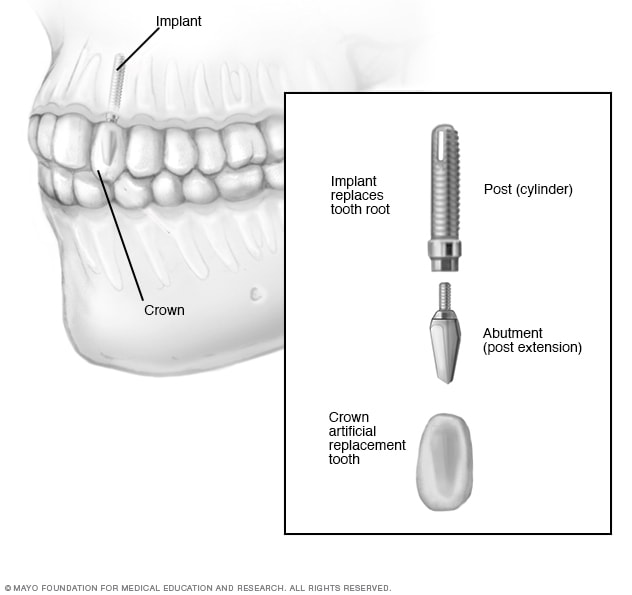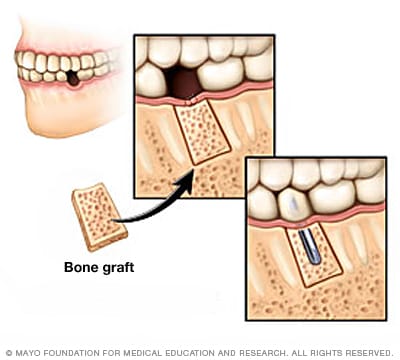Overview
Dental implant surgery

Dental implant surgery
A dental implant is a metal post that replaces the root portion of a missing tooth. A dental professional places an artificial tooth, also known as a crown, on an extension of the post of the dental implant, giving you the look of a real tooth. This extension is known as an abutment.
Dental implant surgery replaces tooth roots with metal, screwlike posts and replaces damaged or missing teeth with artificial teeth that look and work much like real ones. Dental implant surgery can be a helpful choice when dentures or bridgework fit poorly. This surgery also can be an option when there aren't enough natural teeth roots to support dentures or build bridgework tooth replacements.
The type of implant and the condition of the jawbone guide how dental implant surgery is done. This surgery may involve several procedures. The major benefit of implants is solid support for the new teeth — a process that requires the bone to heal tightly around the implant. Because this bone healing requires time, the process can take many months.
Products & Services
Why it's done
Dental implants are surgically placed in your jawbone and serve as the roots of missing teeth. Because the titanium in the implants fuses with your jawbone, the implants won't slip, make noise or cause bone damage like fixed bridgework or dentures might. And the materials can't decay like your own teeth.
Dental implants may be right for you if you:
- Have one or more missing teeth.
- Have a jawbone that's reached full growth.
- Have enough bone to secure the implants or can have a bone graft.
- Have healthy tissues in your mouth.
- Don't have health conditions that can affect bone healing.
- Aren't able or willing to wear dentures.
- Want to improve your speech.
- Are willing to commit several months to the process.
- Don't smoke tobacco.
Risks
Like any surgery, dental implant surgery poses some health risks. These risks are small, and they're usually minor and easily treated when they occur.
Risks include:
- Infection at the implant site.
- Injury or damage to surrounding structures, such as other teeth or blood vessels.
- Nerve damage, which can cause pain, numbness or tingling in your natural teeth, gums, lips or chin.
- Sinus problems, if dental implants placed in the upper jaw poke into one of your sinus cavities.
How you prepare
The planning process for dental implants may involve various specialists, including:
- An oral and maxillofacial surgeon, who is a healthcare professional specializing in conditions of the mouth, jaw and face.
- A periodontist, who is a dentist specializing in treating structures that support the teeth, such as gums and bones.
- A prosthodontist, who is a dentist who designs and fits artificial teeth.
- An ear, nose and throat (ENT) specialist.
Because dental implants require one or more surgical procedures, to prepare for the process you'll likely receive a:
- Full dental exam. You may have dental X-rays and 3D images taken. Also, models may be made of your teeth and jaw.
- Review of your medical history. Tell your healthcare professional about any medical conditions and any medicines that you take, including prescription medicines, medicines available without a prescription and supplements. If you have certain heart conditions or bone or joint implants, your healthcare professional may prescribe antibiotics before surgery to help prevent infection.
- Treatment plan. This plan is made just for you. It considers how many teeth need to be replaced and the condition of your jawbone and remaining teeth.
To control pain, anesthesia options during surgery may include:
- Local anesthesia, in which the area that's worked on is numbed.
- Sedation, which helps you feel calm or less anxious.
- General anesthesia, in which you are in a sleeplike state.
Talk with your dental specialist about which option is best for you. Depending on what type of anesthesia you have, you may need to limit what you eat or drink before surgery. If you're having sedation or general anesthesia, plan to have someone take you home after surgery. Also, expect to rest through the end of the day.
What you can expect
Dental implant surgery usually is an outpatient surgery done in stages, with healing time between procedures. The process of placing a dental implant involves several steps:
- Remove damaged tooth.
- Prepare jawbone, also called grafting, when needed.
- Place dental implant.
- Allow for bone growth and healing.
- Place abutment.
- Place artificial tooth.
The whole process can take many months from start to finish. Much of that time is for healing and waiting for the growth of new bone in your jaw. Depending on your situation, the specific procedure done and the materials used, certain steps can sometimes be combined.
When bone grafting is required
Jawbone graft

Jawbone graft
Your surgeon may need to transplant a small portion of bone — commonly from another site in the upper or lower jawbone — to give the dental implant a solid foundation.
If your jawbone isn't thick enough or is too soft, you may need bone grafting before you can have dental implant surgery. That's because the powerful chewing action of your mouth puts great pressure on your bone. If your bone can't support the implant, the surgery likely would fail. A bone graft can create a more solid base for the implant.
Your dental professional can use several bone graft materials to rebuild your jawbone. Options may include a natural bone graft, such as from another location in your body. Another option is a synthetic bone graft, such as bone-substitute material that can provide more support for new bone growth. Other options include bone from a human donor or from an animal source. Talk with your dental professional about which option is best for you.
It may take several months for the transplanted bone to grow enough new bone to support a dental implant. In some cases, you may need only minor bone grafting. If this is the case, your dental specialist can do it at the same time as the implant surgery. The condition of your jawbone determines how to proceed.
Placing the dental implant
During surgery to place the dental implant, your surgeon makes a cut to open your gum and expose the bone. Then your surgeon drills holes into the bone where the dental implant metal post will be placed. Since the post will serve as the tooth root, it's implanted deep into the bone.
At this point, you'll still have a gap where your tooth is missing. A type of partial, temporary denture can be placed for appearance, if needed. You can remove this denture for cleaning and while you sleep.
Waiting for bone growth
Once the surgeon places the metal implant post in your jawbone, osseointegration (os-e-o-in-tuh-GRAY-shun) begins. Osseointegration is the process of forming a connection between the bone and the implant. During this process, the jawbone grows into, and joins with, the surface of the dental implant. This process helps provide a solid base for your new artificial tooth — just as roots do for your natural teeth. The process can take several months.
Placing the abutment
When osseointegration is complete, you may need more surgery to place the abutment — the piece where the crown eventually attaches. Usually, this minor surgery is done in an outpatient setting using medicine that numbs the area that's worked on.
To place the abutment, your surgeon:
- Reopens your gum to expose the dental implant.
- Attaches the abutment to the dental implant.
- Closes the gum tissue around but not over the abutment.
Your surgeon may attach the abutment to the dental implant metal post when the post is implanted. That means you won't need an extra surgical step. But because the abutment juts past the gumline, you can see it when you open your mouth. It will be that way until your surgeon completes the tooth replacement. Some people don't like the way that looks and prefer a separate procedure to place the abutment.
After your surgeon places the abutment, your gums must heal for at least two weeks before your general dentist or prosthodontist can attach the artificial tooth.
Choosing your new artificial teeth
Once your gums heal, your general dentist or prosthodontist makes more impressions of your mouth and remaining teeth. These impressions are used to make the crown — your realistic-looking artificial tooth. Your general dentist or prosthodontist can't place the crown until your jawbone is strong enough to support use of the new tooth.
You and your dentist or prosthodontist can choose artificial teeth that are:
- Removable. This type is like a conventional removable denture and can be a partial or full denture. It contains artificial white teeth surrounded by pink plastic gum. It's mounted on a metal frame that's attached to the implant abutment, and it snaps securely into place. It can be easily removed for repair or daily cleaning.
- Fixed. In this type, an artificial tooth is permanently screwed or cemented onto an individual implant abutment. You can't take out the tooth for cleaning or sleep. Most of the time, each crown is attached to its own dental implant. But because implants are very strong, one implant can replace several teeth if those teeth are bridged together.
Or artificial teeth can be a mix of removable and fixed.
After the procedure
Whether you have dental implant surgery in one stage or more than one stage, you may have some discomfort, such as:
- Swelling of the gums and face.
- Bruising of the skin and gums.
- Pain at the implant site.
- Minor bleeding.
You may need pain medicines or antibiotics after dental implant surgery. If swelling, soreness or any other problem gets worse in the days after surgery, contact your surgeon.
After each stage of surgery, you may need to eat soft foods while the surgical site heals. Your surgeon will likely use stitches that dissolve on their own. If your stitches don't dissolve on their own, they will be removed on future follow-up visits.
Results
Most dental implants are successful. But sometimes the bone fails to fuse enough to the metal implant. For example, smoking may play a part in implant failure and complications.
If the bone fails to fuse enough, the implant is removed and the bone is cleaned up. Then you can try the procedure again in about three months.
You can help your dental work — and the rest of your natural teeth — last longer if you:
- Keep your teeth and gums clean. Just as with your natural teeth, keep implants, artificial teeth and gum tissue clean. A specially designed brush, such as an interdental brush that slides between teeth, can help clean the nooks and crannies around teeth, gums and metal posts.
- See your dentist regularly. Schedule dental checkups to make sure your implants are healthy and working properly. Follow your dentist's advice for professional cleanings.
- Avoid damaging habits. Don't chew hard items, such as ice and hard candy, which can break your crowns or your natural teeth. Stay away from tooth-staining tobacco and caffeine products. Get treatment if you grind your teeth.
Oct. 23, 2024